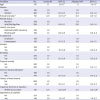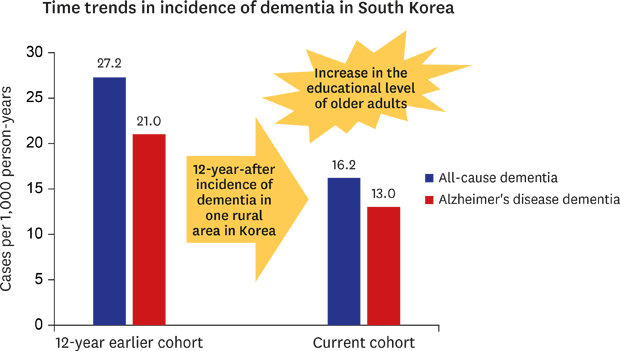1. Kim KW. Nationwide Study on the Prevalence of Dementia in Korean Elders. Sejong: Ministry of Health and Welfare;2012.
2. Ferri CP, Prince M, Brayne C, Brodaty H, Fratiglioni L, Ganguli M, et al. Global prevalence of dementia: a Delphi consensus study. Lancet. 2005; 366(9503):2112–2117.
3. Statistics Korea. Report on the Population and Housing Census. Daejeon: Statistics Korea;2018.
4. Schrijvers EM, Verhaaren BF, Koudstaal PJ, Hofman A, Ikram MA, Breteler MM. Is dementia incidence declining?: trends in dementia incidence since 1990 in the Rotterdam study. Neurology. 2012; 78(19):1456–1463.

5. Gao S, Ogunniyi A, Hall KS, Baiyewu O, Unverzagt FW, Lane KA, et al. Dementia incidence declined in African-Americans but not in Yoruba. Alzheimers Dement. 2016; 12(3):244–251.
6. Grasset L, Brayne C, Joly P, Jacqmin-Gadda H, Peres K, Foubert-Samier A, et al. Trends in dementia incidence: evolution over a 10-year period in France. Alzheimers Dement. 2016; 12(3):272–280.

7. Matthews FE, Stephan BC, Robinson L, Jagger C, Barnes LE, Arthur A, et al. A two decade dementia incidence comparison from the Cognitive Function and Ageing Studies I and II. Nat Commun. 2016; 7(1):11398.
8. Satizabal CL, Beiser AS, Chouraki V, Chêne G, Dufouil C, Seshadri S. Incidence of dementia over three decades in the Framingham heart study. N Engl J Med. 2016; 374(6):523–532.

9. Wu YT, Beiser AS, Breteler MM, Fratiglioni L, Helmer C, Hendrie HC, et al. The changing prevalence and incidence of dementia over time - current evidence. Nat Rev Neurol. 2017; 13(6):327–339.
10. Stephan BC, Birdi R, Tang EY, Cosco TD, Donini LM, Licher S, et al. Secular trends in dementia prevalence and incidence worldwide: a systematic review. J Alzheimers Dis. 2018; 66(2):653–680.

11. Li S, Yan F, Li G, Chen C, Zhang W, Liu J, et al. Is the dementia rate increasing in Beijing? Prevalence and incidence of dementia 10 years later in an urban elderly population. Acta Psychiatr Scand. 2007; 115(1):73–79.
12. Ohara T, Hata J, Yoshida D, Mukai N, Nagata M, Iwaki T, et al. Trends in dementia prevalence, incidence, and survival rate in a Japanese community. Neurology. 2017; 88(20):1925–1932.

13. Kim YJ, Han JW, So YS, Seo JY, Kim KY, Kim KW. Prevalence and trends of dementia in Korea: a systematic review and meta-analysis. J Korean Med Sci. 2014; 29(7):903–912.
14. Kim JK, Kim SU, Hahm BJ, Lee JY. Three and half year follow-up study on a rural elderly cohort: prevalence, incidence, and service utilization of dementia and depressive disorders. J Korean Geriatr Psychiatry. 2002; 6(2):88–96.
15. Lee JY. The incidence and course of dementia of Alzheimer type and their relationship with apolipoprotein E genotype. Seoul: Seoul National University Graduate School;2005.
16. Lee JY, Chang SM, Jang HS, Chang JS, Suh GH, Jung HY, et al. Illiteracy and the incidence of Alzheimer's disease in the Yonchon County survey, Korea. Int Psychogeriatr. 2008; 20(5):976–985.

17. Bae JB, Kim YJ, Han JW, Kim TH, Park JH, Lee SB, et al. Incidence of and risk factors for Alzheimer's disease and mild cognitive impairment in Korean elderly. Dement Geriatr Cogn Disord. 2015; 39(1-2):105–115.
18. Statistics Korea. Report on the Population and Housing Census. Daejeon: Statistics Korea;2005.
19. Lee DY, Lee KU, Lee JH, Kim KW, Jhoo JH, Kim SY, et al. A normative study of the CERAD neuropsychological assessment battery in the Korean elderly. J Int Neuropsychol Soc. 2004; 10(1):72–81.

20. Lee JH, Lee KU, Lee DY, Kim KW, Jhoo JH, Kim JH, et al. Development of the Korean version of the Consortium to Establish a Registry for Alzheimer's Disease Assessment Packet (CERAD-K): clinical and neuropsychological assessment batteries. J Gerontol B Psychol Sci Soc Sci. 2002; 57(1):47–53.
21. American Psychiatric Association. Diagnostic and Statistical Manual of Mental Disorders (DSM-IV). Washington, D.C.: American Psychiatric Association;1994.
22. McKhann G, Drachman D, Folstein M, Katzman R, Price D, Stadlan EM. Clinical diagnosis of Alzheimer's disease: report of the NINCDS-ADRDA Work Group under the auspices of Department of Health and Human Services Task Force on Alzheimer's Disease. Neurology. 1984; 34(7):939–944.

23. Petersen RC. Mild cognitive impairment as a diagnostic entity. J Intern Med. 2004; 256(3):183–194.
24. Chun MY. Validity and reliability of Korean version of international physical activity questionnaire short form in the elderly. 2012; 33(3):144–151.

25. Bae JN, Cho MJ. Development of the Korean version of the Geriatric Depression Scale and its short form among elderly psychiatric patients. J Psychosom Res. 2004; 57(3):297–305.
26. Norton S, Matthews FE, Barnes DE, Yaffe K, Brayne C. Potential for primary prevention of Alzheimer's disease: an analysis of population-based data. Lancet Neurol. 2014; 13(8):788–794.

27. Farias ST, Mungas D, Reed BR, Harvey D, DeCarli C. Progression of mild cognitive impairment to dementia in clinic- vs community-based cohorts. Arch Neurol. 2009; 66(9):1151–1157.
28. Opdebeeck C, Matthews FE, Wu YT, Woods RT, Brayne C, Clare L. Cognitive reserve as a moderator of the negative association between mood and cognition: evidence from a population-representative cohort. Psychol Med. 2018; 48(1):61–71.

29. Statistics Korea. Report on the Population and Housing Census. Daejeon: Statistics Korea;2015.
30. Kukull WA, Higdon R, Bowen JD, McCormick WC, Teri L, Schellenberg GD, et al. Dementia and Alzheimer disease incidence: a prospective cohort study. Arch Neurol. 2002; 59(11):1737–1746.
31. Meng X, D'Arcy C. Education and dementia in the context of the cognitive reserve hypothesis: a systematic review with meta-analyses and qualitative analyses. PLoS One. 2012; 7(6):e38268.

32. Mungas D, Gavett B, Fletcher E, Farias ST, DeCarli C, Reed B. Education amplifies brain atrophy effect on cognitive decline: implications for cognitive reserve. Neurobiol Aging. 2018; 68:142–150.
33. Suh SW, Han JW, Park JY, Hong JW, Kim K, Kim T, et al. Impacts of illiteracy on the risk of dementia: a global health perspective. J Alzheimers Dis. 2016; 53(2):731–741.

34. Statistics Korea. 2006 Senior Citizen Statistics. Daejeon: Statistics Korea;2006.
35. Ministry of Health and Welfare. 2017 Survey of the Elderly. Sejong: Ministry of Health and Welfare, Korea Institute for Health and Social Affairs;2017.
36. Lee Y. The recent decline in prevalence of dementia in developed countries: implications for prevention in the Republic of Korea. J Korean Med Sci. 2014; 29(7):913–918.
37. Jorm AF, Mackinnon AJ, Henderson AS, Scott R, Christensen H, Korten AE, et al. The Psychogeriatric Assessment Scales: a multi-dimensional alternative to categorical diagnoses of dementia and depression in the elderly. Psychol Med. 1995; 25(3):447–460.

38. Wancata J, Börjesson-Hanson A, Ostling S, Sjögren K, Skoog I. Diagnostic criteria influence dementia prevalence. Am J Geriatr Psychiatry. 2007; 15(12):1034–1045.








 PDF
PDF Citation
Citation Print
Print




 XML Download
XML Download